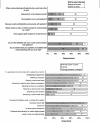Physicians' use of and attitudes toward electronic mail for patient communication
- PMID: 12795738
- PMCID: PMC1494854
- DOI: 10.1046/j.1525-1497.2003.20627.x
Physicians' use of and attitudes toward electronic mail for patient communication
Abstract
To assess physicians' use of and attitudes toward electronic mail (e-mail) for patient communication, we conducted a mail-in survey of physicians who see patients in outpatient clinics affiliated with a large academic medical center (N = 283). Seventy-two percent of physicians reported using e-mail to communicate with patients, averaging 7.7 e-mails from patients per month. The lowest level of use was by community-based primary care physicians (odds ratio, 0.22; 95% confidence interval, 0.08 to 0.59). Those physicians who reported using e-mail with patients reported high satisfaction with its use. Although physicians were concerned about the confidentiality of e-mail, few discussed this issue with patients.
Figures
References
-
- Nielsen Net Ratings. Web usage. Available at: http://209.249.142.27/nnpm/owa/NRpublicreports.usageweekly. Accessed September 5, 2002.
-
- Coile RC., Jr The digital transformation of health care. Physician Exec. 2000;26:8–15. - PubMed
-
- Sands DZ. Electronic patient-centered communication: managing risks, managing opportunities, managing care. Am J Manag Care. 1999;5:1569–71. - PubMed
-
- Mandl KD, Kohane IS, Brandt AM. Electronic patient-physician communication: problems and promise. Ann Intern Med. 1998;129:495–500. - PubMed
-
- Spielberg AR. On call and online: sociohistorical, legal, and ethical implications of e-mail for the patient-physician relationship. JAMA. 1998;280:1353–9. - PubMed
MeSH terms
LinkOut - more resources
Full Text Sources
Medical

